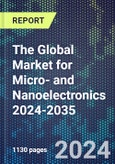Micro- and nanoelectronics refer to the study, design, and fabrication of electronic devices and systems at the micro- and nanoscale levels. These fields encompass a wide range of technologies and applications, leveraging the unique properties and behaviours of materials and structures at these scale levels. Microelectronics deals with the development of electronic devices and components with dimensions ranging from a few micrometers (10^-6 meters) to a few millimeters. It includes the design and manufacture of integrated circuits (ICs), microprocessors, microcontrollers, and other microscale electronic devices. Nanoelectronics focuses on the manipulation and exploitation of materials, devices, and systems at the nanoscale level, typically ranging from 1 to 100 nanometers (10^-9 meters).
This field explores the unique physical, chemical, and electrical properties that emerge at the nanoscale, enabling the creation of novel electronic devices and systems with enhanced performance, efficiency, and functionality. Ongoing miniaturization combined with performance improvements and increasing functionality as well as the integration of novel materials, radically new device concepts and new applications are pushing technological limits further and further. As such, micro- and nanoelectronics is the key and enabling technology for innovation in all areas of life. Megatrends such as artificial intelligence or the metaverse as well as critical infrastructures such as power plants or telecommunications networks, are heavily dependent on micro- and nanoelectronics.
Micro- and nanoelectronics are driving innovations across industries, from consumer electronics and computing to healthcare, energy, and advanced manufacturing. This in-depth market report provides a comprehensive analysis of the global micro- and nanoelectronics landscape, including market sizing, emerging trends, key drivers and opportunities, competitive landscape, and future outlook.
The report includes a detailed introduction to micro- and nanoelectronics, covering definitions, importance, applications, and major market segments such as consumer electronics, computing, communications, automotive, aerospace and defense, healthcare, energy, industrial automation, Internet of Things (IoT), and optoelectronics.
A core focus is on the device technology driving micro- and nanoelectronics innovations, including transistors (FinFETs, Gate-All-Around FETs, Tunnel FETs, Carbon Nanotube FETs), integrated circuits, MEMS devices, nanoelectronic structures (carbon nanotubes, graphene, quantum dots), optoelectronic devices (LEDs, lasers, photodetectors), and energy storage/conversion devices. Market sizing and forecasts are provided for each device type through 2035.
The report also covers the electronic circuits and architectures powering today's systems, examining analog and mixed-signal circuits, microprocessors/microcontrollers, FPGAs, ASICs, System-on-Chip designs, memory architectures (DRAM, SRAM, emerging non-volatile), and advanced interconnects/packaging technologies like 3D ICs, chiplets, fan-outs, and silicon interposers. Again, comprehensive market data is included. Emerging technologies like spintronics, molecular electronics, neuromorphic computing, and 3D printed electronics are analyzed regarding their current status, applications, key players, and future potential.
The market analysis section covers key trends, applications, and market forecasts across industries:
- Consumer Electronics (smartphones, wearables, home appliances)
- Computing and Data Storage
- Communications
- Automotive Electronics (ADAS, displays, sensors)
- Aerospace & Defense
- Healthcare and Biomedical (imaging, biosensors, wearables, implantables)
- Energy and Power (solar cells, energy harvesting, power management)
- Industrial Automation
- IoT (smart home, cities, sensor networks)
- Optoelectronics (displays, lighting, photonics)
- Sustainable Electronics
- Smart Packaging Electronics
Over 1,100 company profiles are included, covering start-ups to industry leaders across devices, circuits, packaging, end-use applications, and enabling technologies. Companies profiled include 3DSEMI, AMD (Advanced Micro Devices), Aspinity, BeFC, C3 Nano, Canatu, CHASM, ChipMOS, Chiral Nano, Efficient Computer, Electroninks, Elephantech, Eliyan Corporation, e-peas Semiconductors, Heraeus Epurio, Inkron Oy (Nagase), Innatera Nanosystems, Lotus Microsystems, Lumotive, Lux Semiconductors, MICLEDI Microdisplays, Neurophos, Ookuma Diamond Device, Oriole Networks, Point2 Technology, Pragmatic Semiconductor, Printoptix, PVNanoCell, SiFive, Silicon Box, SK hynix, SynSense, tacterion GmbH, Tactotek, Taiwan Semiconductor Manufacturing Company (TSMC), TopoLogic, TracXon, Voltera, Wise Integration, Xymox Technologies, Inc. and Ynvisible.
With insights into the latest market developments, disruptive technologies, competitive strategies, and opportunities across applications, this report is an invaluable resource for companies, investors, and professionals navigating the dynamic micro- and nanoelectronics space.
Table of Contents
1 RESEARCH METHODOLOGY
Companies Mentioned (Partial List)
A selection of companies mentioned in this report includes, but is not limited to:
- 3DSEMI, AMD (Advanced Micro Devices)
- Aspinity
- BeFC
- C3 Nano
- Canatu
- CHASM
- ChipMOS
- Chiral Nano
- Efficient Computer
- Electroninks
- Elephantech
- Eliyan Corporation
- e-peas Semiconductors
- Heraeus Epurio
- Inkron Oy (Nagase)
- Innatera Nanosystems
- Lotus Microsystems
- Lumotive
- Lux Semiconductors
- MICLEDI Microdisplays
- Neurophos
- Ookuma Diamond Device
- Oriole Networks
- Point2 Technology
- Pragmatic Semiconductor
- Printoptix
- PVNanoCell
- SiFive
- Silicon Box
- SK hynix
- SynSense
- tacterion GmbH
- Tactotek
- Taiwan Semiconductor Manufacturing Company (TSMC)
- TopoLogic
- TracXon
- Voltera
- Wise Integration
- Xymox Technologies, Inc.
- Ynvisible
Methodology

LOADING...








